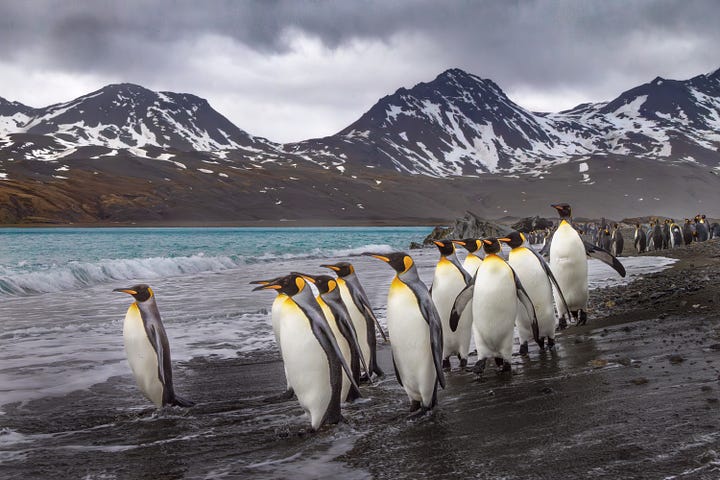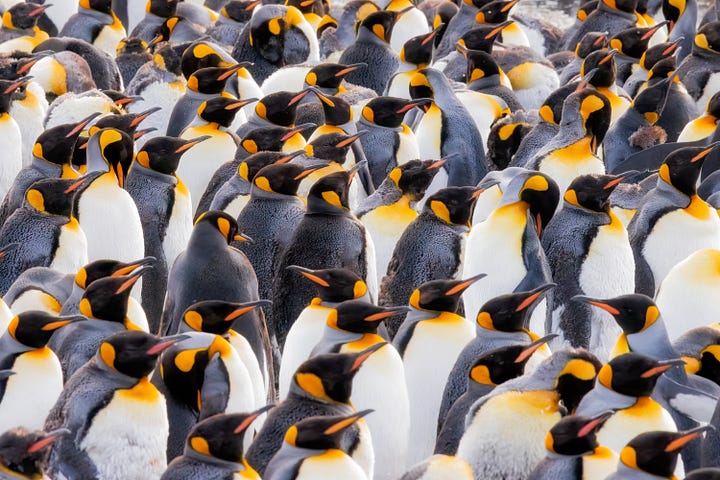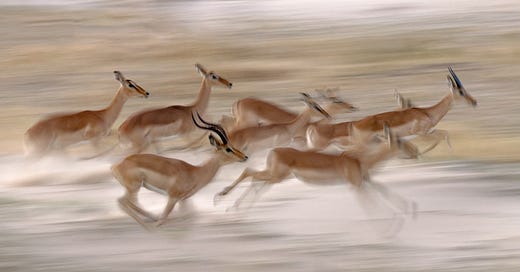Wildlife and the Illusion of Motion
(Above) “Vundu Rhythm” Mana Pools National Park, Zimbabwe. Canon EOS R5, Canon 100-500mm @ 500mm, 1/20 second @ f/8, ISO 100
Dragging the shutter while panning the camera with moving wildlife can do something magical: it creates the illusion of motion in a still image.
In wildlife photography, the addition of that extra dimension is rare. Most of the time, photographers chase sharpness and clarity, freezing the action to produce an image that’s more documentary than expressive. But dragging the shutter and panning flips that script. You’re no longer capturing an animal in motion; you’re capturing motion itself. It’s a subtle but profound distinction, and one of the reasons images like this feel more like visual poetry than a visual statement.
Tips
Needless to say, the shutter speed you choose is important. You want the implication of motion while preserving enough detail to keep your subjects recognizable. Too slow, and it becomes too abstract. Too fast, and it just looks like a blurry mistake—too literal and out of focus. It needs to look purposeful.
Factors that can affect the aesthetic result of a chosen shutter speed include:
– The velocity of the movement (the faster the movement, the faster the shutter speed, and vice versa)
– Focal length (longer focal lengths exaggerate movement; shorter lenses minimize it)
– Subject distance (closer subjects require faster speeds; more distant ones, slower)
Experiment. Most attempts will be failures, so expect lots of them. My default starting point is 1/15 second. For slower subjects, I might try 1/10 or even 1/8. For faster ones, I’ll go to 1/20, 1/30, or even 1/50. Consider all the factors I mentioned above.
If your lenses have customizable stabilization settings, opt for the one that stabilizes in a single direction. For example, if you’re panning horizontally, enable vertical-only stabilization. There might be a mode that does this automatically. This will produce smoother results.
I have a custom setting on my cameras that I can quickly access: Shutter Priority (aperture is nearly irrelevant since the background will be blurry anyway), 1/15 second, Auto ISO. I override as needed.
You’ll get the best results when the movement is at a 90-degree angle to your shooting direction.
You’ll also get the best results when the movement is smooth and consistent. A running bear, for example, has a lot of vertical movement, so good results are rare. Horses, zebras, most slow-flying birds, and impalas have smoother and more uniform movement.
Lock focus and begin panning before pressing the shutter release. Use continuous focus and hold down the shutter button, capturing as many frames as you can as the animal(s) pass. Keep your motion smooth and match the rate of the animal’s movement. I use spot focus, and I keep that focus point trained on one part of the animal, following it the entire way. Continue tracking even after you’ve finished shooting.
Soft, diffused light works better - visually and aesthetically - than direct light.
Additional Lessons
Consider the conditions in the image above: it’s about 10 minutes past sunset and darkness is approaching fast. My settings for the image were 1/20 second at f/8, ISO 100. If I had wanted to capture these speedy impalas tack-sharp, the default approach for most wildlife photographers, I would have needed at least a 1/2500 second shutter speed. Using the original exposure as a base, I’d also need a 12,800 ISO. How many times, in low-light conditions, have you given up on the shot because the ISO would be too high? 100 ISO versus 12,800 ISO.
Also, most people don’t travel to Africa on a photo safari hoping to capture impalas, warthogs, or jackals. They want the glamour species: lions, leopards, elephants, and rhinos. That’s understandable. But lesser-loved species, like impalas, should not be overlooked. Good wildlife art can be made from almost any species if you look for it. An impactful wildlife image is more about vision and creative expression than subject identity.
ICYMI: New Podcast Episode with Marc Adamus
Episode 92 - Adventure Photographer and Filmmaker on Embracing Uncertainty and Discomfort to Discover Creativity and Joy
Marc Adamus is one of the most celebrated landscape photographers working today. Known for his dramatic compositions and fearless pursuit of remote wilderness, Marc has carved out a unique space at the intersection of fine art and adventure. He spends 300 days each year making images, often in extreme conditions and far-flung locations, which have been featured in National Geographic, Outdoor Photographer, Digital Camera, and Photo District News, among many others.
His new book, The Way Home, was released this week and features twenty years worth of Marc's photography captured from remote locations around the world.
Latest Episodes of Beyond The Lens:
Quote from my Favorite Philosopher
“If you live in harmony with nature you will never be poor; if you live according what others think, you will never be rich.” ― Seneca, Letters from a Stoic
Featured Workshop: The Falklands and South Georgia Island


I’ve traveled to nearly every wildlife and nature photography hotspot in the world. And I can honestly say that South Georgia Island is still the one place that’s had the greatest impact on me personally and as a photographer.
Join me and Muench Workshops for a Southern Ocean adventure like no other! On this all-inclusive 18-day journey, we’ll experience the region’s best, including the subantarctic Falkland Islands and South Georgia Island. This trip focuses on two of the richest wildlife concentrations on the planet! We’ll encounter diverse and abundant wildlife, be awed by expansive landscapes, and visit historic sites that evoke the days of early exploration. Contact me if you have any questions or get more information here.
Falklands and South Georgia Island, October 24 – November 10, 2026
Follow My Instagram
I’ve found myself using Instagram stories to share experiences and visual vignettes during my travels and I’ll be doing a lot more of the same in 2025. If this interests you, you can follow me here.
Kase Filters
People often ask what filter system I use. The answer is Kase Filters.
And you can get 10% off any product on the Kase Filters Amazon Page when you use coupon code BERNABE10 at check out.
*****
Here’s to Truth, Adventure, and Passion…








Creativity defined 💎📸💎